Lake Titicaca is considered the world largest navigable, high-altitude lake at 3,808m. The lake is 165km long, 60km wide and they think around 300m deep. The lake is massive and approximately sixty percent of it is in Peru, the remaining forty percent is in Bolivia.
Puno
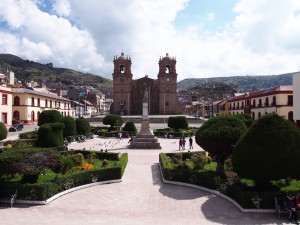 Puno is a large city on the edge of the lake, that seems to operate as an access point to the islands on the lake. The centre of Puno has many old but gorgeous colonial buildings. A little further out of town are bumpy dirt roads and mud brick houses. The main street of Puno has many cute shops and restaurants, some nice old cathedrals and set back behind a school is a local market.
Puno is a large city on the edge of the lake, that seems to operate as an access point to the islands on the lake. The centre of Puno has many old but gorgeous colonial buildings. A little further out of town are bumpy dirt roads and mud brick houses. The main street of Puno has many cute shops and restaurants, some nice old cathedrals and set back behind a school is a local market.
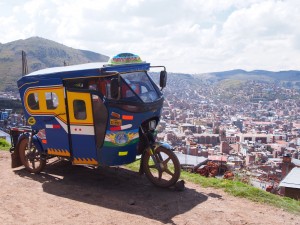 Up on the hill overlooking the city is a rather ugly statue of a condor, one of the most important animals in the Peruvian culture. Despite the ugly statue it provides an amazing view of the entire city of Puno and the lake.
Up on the hill overlooking the city is a rather ugly statue of a condor, one of the most important animals in the Peruvian culture. Despite the ugly statue it provides an amazing view of the entire city of Puno and the lake.
Taquile Island
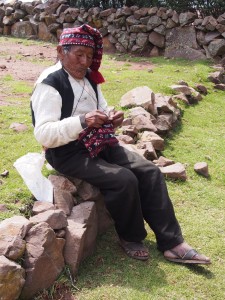 Taquile Island is a UNESCO protected island that maintains much of the original culture. The island has a population of 2500 people. They are known for knitting, weaving and farming. The men on the island are some of the best knitters in the world.
Taquile Island is a UNESCO protected island that maintains much of the original culture. The island has a population of 2500 people. They are known for knitting, weaving and farming. The men on the island are some of the best knitters in the world.
The island is gorgeous and provides a brilliant insight into the lives of the people. One of the things I found fascinating was the traditional clothing that is very colourful and steeped in tradition.
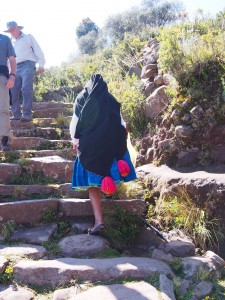 The men wear black pants, a white shirt with a short black waist coat and a decorative knitted belt. The single men wear a hat/beanie that’s predominantly white, with some colour at the top. but married men have a beanie that’s colourful all over.
The men wear black pants, a white shirt with a short black waist coat and a decorative knitted belt. The single men wear a hat/beanie that’s predominantly white, with some colour at the top. but married men have a beanie that’s colourful all over.
The women wear layers of brightly coloured skirts, bright tops and wear a black shawl with brightly coloured pom poms hanging off it. Single women display four pom poms, and the pom poms are very big. Married women have pom poms that are smaller, and they only display three.
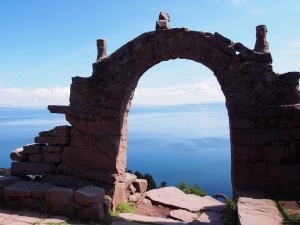 The other thing I found fascinating is that when men greet each other, they don’t shake hands, they give each other some coca leaves from their bag.
The other thing I found fascinating is that when men greet each other, they don’t shake hands, they give each other some coca leaves from their bag.
Llachon
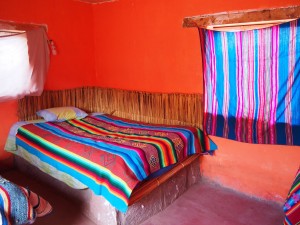 Lllachon is on a peninsula and this was where we had a homestay with a local community. We were each allocated to a family; I was together with three others from the group. Our homestay mum was Pastora. She had a gorgeous little son named Sebastian. We were given private little mud brick huts to sleep in. The beds were also made of mud brick, covered with a layer of reeds, then the mattress and bedding.
Lllachon is on a peninsula and this was where we had a homestay with a local community. We were each allocated to a family; I was together with three others from the group. Our homestay mum was Pastora. She had a gorgeous little son named Sebastian. We were given private little mud brick huts to sleep in. The beds were also made of mud brick, covered with a layer of reeds, then the mattress and bedding.
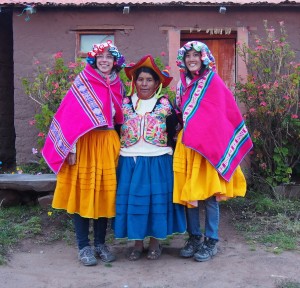 We helped our homestay mum to till the fields and harvest potatoes. We then gathered with the rest of the community to play some volleyball (or in my case, take pictures). After the fun, we all were dressed in traditional clothing.
We helped our homestay mum to till the fields and harvest potatoes. We then gathered with the rest of the community to play some volleyball (or in my case, take pictures). After the fun, we all were dressed in traditional clothing.
The traditional dress in Llachon differs from that of Tequile Island, but still shows the distinction between single and married people.
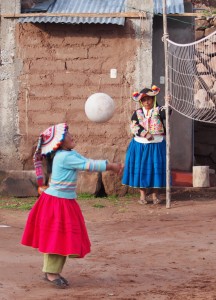 The single men wear brightly coloured poncho’s and beanies, while the married men wear more muted colours. The women wear brightly coloured skirts, a white embroidered shirt, knitted belt, coloured shawl and a beanie that is long and colourful, but has a white frilly edge around the face.
The single men wear brightly coloured poncho’s and beanies, while the married men wear more muted colours. The women wear brightly coloured skirts, a white embroidered shirt, knitted belt, coloured shawl and a beanie that is long and colourful, but has a white frilly edge around the face.
Married women have a black embroidered jacket over their shirt, rather than a shawl, and wear a black hat with two pom poms.
 On both islands, the mean make the hats. jackets, belts and so on for their wives, as a sign of love. Similarly, the women make the beanies, belts and bags for their husbands. A man who goes to a party wearing many bags (thirty or more) is a very proud man, as he has so much of his wife’s love on display.
On both islands, the mean make the hats. jackets, belts and so on for their wives, as a sign of love. Similarly, the women make the beanies, belts and bags for their husbands. A man who goes to a party wearing many bags (thirty or more) is a very proud man, as he has so much of his wife’s love on display.
Once we were in our traditional dress, we all headed to the kitchen where we chopped up vegetables for the evening meal. Our families cooked for us and we ate a delicious meal of all home grown and freshly harvested vegetables.
The next morning we had another freshly cooked meal, before saying our goodbyes.
Uros Islands
 The Uros Islands are floating islands made of reeds. They are clustered in roughly the same area and are made up of around 50 islands. The islands are built with layers of buoyant reeds called Totora reeds. As the reeds rot, the islands are built up with more layers of reeds on top.
The Uros Islands are floating islands made of reeds. They are clustered in roughly the same area and are made up of around 50 islands. The islands are built with layers of buoyant reeds called Totora reeds. As the reeds rot, the islands are built up with more layers of reeds on top.
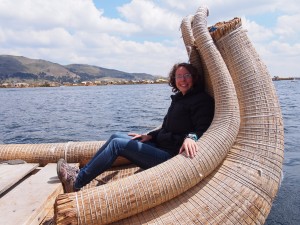 We spent a very short time on the Uros Islands, but were shown how the Islands are constructed and we were shown the simple lifestyle of the inhabitants. The Islands have become quite commercial, but are still interesting to visit.
We spent a very short time on the Uros Islands, but were shown how the Islands are constructed and we were shown the simple lifestyle of the inhabitants. The Islands have become quite commercial, but are still interesting to visit.
For all my Lake Titicaca photos, check out my album on Flickr.

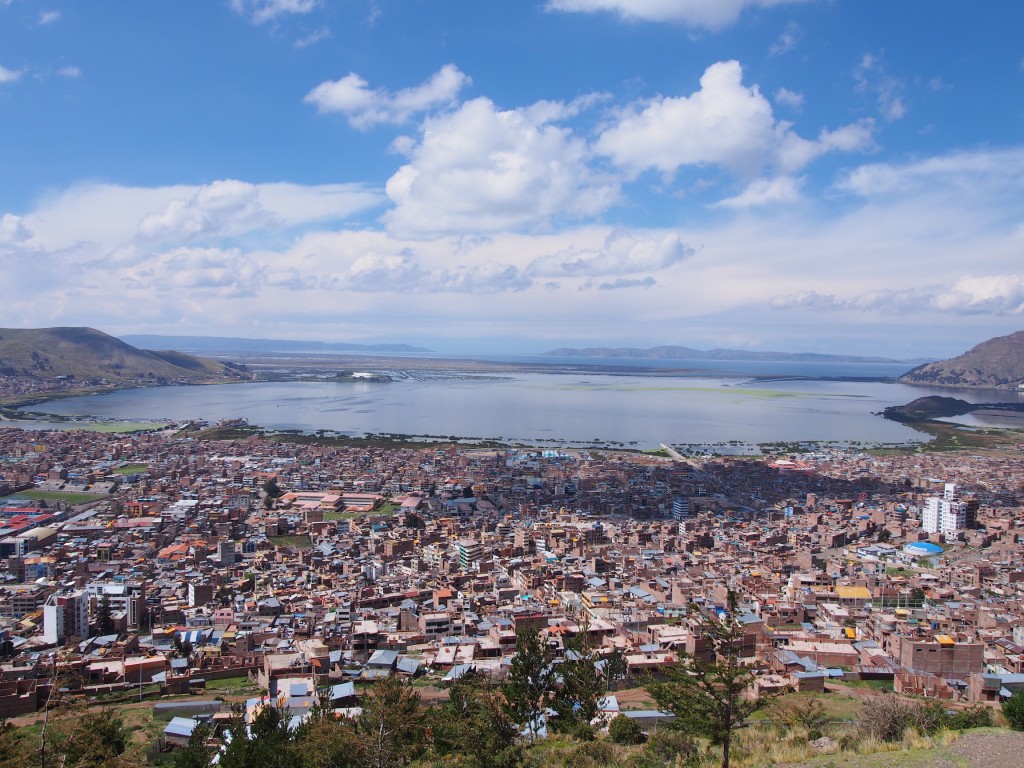
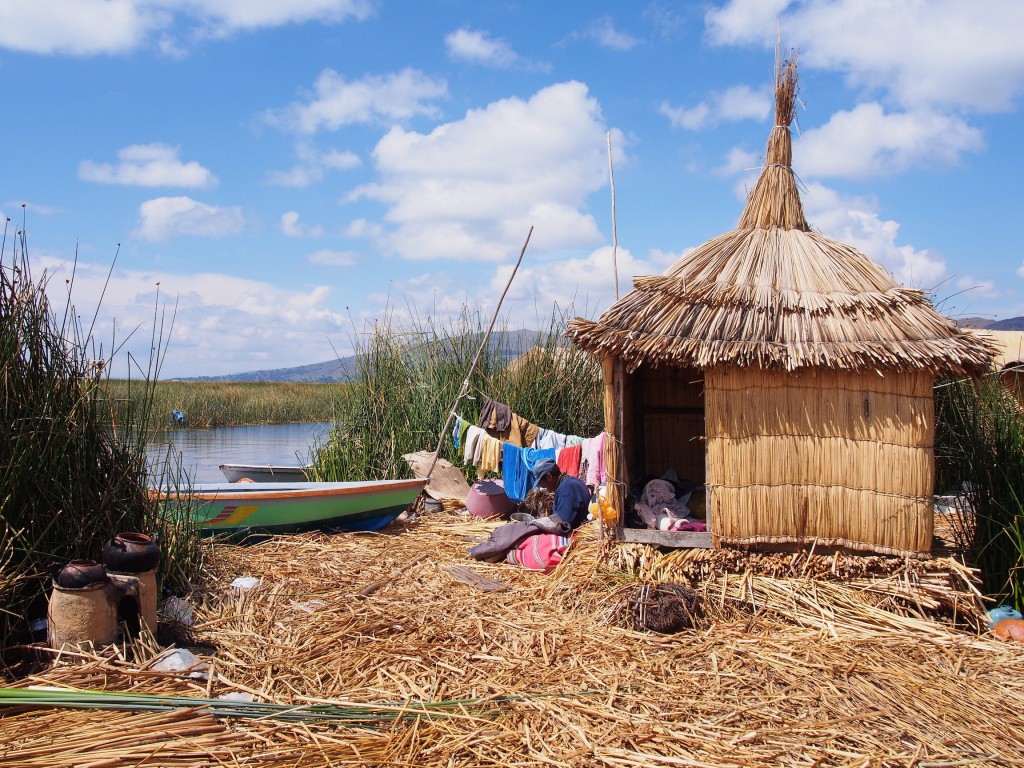
Haha I’m not sure I’d like people to know by count of pom pom that I’m still f+$ing single! I love the colors! Bright and beautiful. I was fascinated by the way men show their love through creating things for women and that men are they best at weaving and knitting. Miss u x